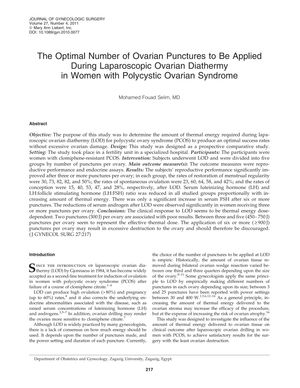TLDR Three to five ovarian punctures are best for improving fertility in women with PCOS without harming the ovaries.
The study, involving 76 women with clomiphene-resistant polycystic ovary syndrome (PCOS), aimed to identify the optimal number of ovarian punctures during laparoscopic ovarian diathermy (LOD) to improve reproductive outcomes without causing excessive ovarian damage. The participants were divided into five groups, receiving between two to eight punctures per ovary. The findings suggested that three to five punctures per ovary (450–750J) were most effective, improving menstrual regularity, spontaneous ovulation, and conception rates, while also significantly reducing serum androgen levels. However, six or more punctures (≥900J) increased serum follicle-stimulating hormone (FSH) levels, indicating potential harm to ovarian reserve. The study concluded that the optimal thermal dose for LOD in women with PCOS is between 450J and 750J, with three to five punctures per ovary, and that more than six punctures may lead to excessive ovarian destruction.
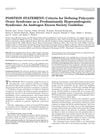 1744 citations
,
August 2006 in “The Journal of Clinical Endocrinology and Metabolism”
1744 citations
,
August 2006 in “The Journal of Clinical Endocrinology and Metabolism” Polycystic Ovary Syndrome should be seen mainly as a condition of excess male hormones, with a focus on this in its definition.
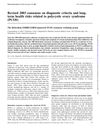 4025 citations
,
December 2003 in “Human Reproduction”
4025 citations
,
December 2003 in “Human Reproduction” The 2003 consensus updated PCOS diagnosis criteria and linked PCOS to higher risks of diabetes and heart problems, recommending lifestyle changes to lower these risks.
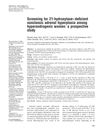 216 citations
,
November 1999 in “Fertility and Sterility”
216 citations
,
November 1999 in “Fertility and Sterility” Testing basal 17-HP levels is a good way to screen for nonclassic adrenal hyperplasia in women with high androgen levels.
514 citations
,
February 2011 in “International journal of women's health” Different treatments for PCOS focus on the specific symptoms, with weight loss and lifestyle changes being important.
 74 citations
,
January 2006 in “Endocrine journal”
74 citations
,
January 2006 in “Endocrine journal” Low-dose gonadotropin treatment is effective for infertility in women with PCOS, leading to high ovulation rates and comparable pregnancy rates with fewer complications.
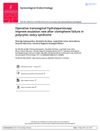 9 citations
,
May 2017 in “Gynecological Endocrinology”
9 citations
,
May 2017 in “Gynecological Endocrinology” Transvaginal hydrolaparoscopy is effective for increasing ovulation and pregnancy rates in women with PCOS who didn't respond to clomiphene.
21 citations
,
November 2017 in “Cochrane library” Ovarian drilling surgery is not clearly better than medical treatments for PCOS symptoms.

There are many ways to treat Polycystic Ovary Syndrome, including lifestyle changes, surgery, and various medications, but more research is needed for better treatments.
